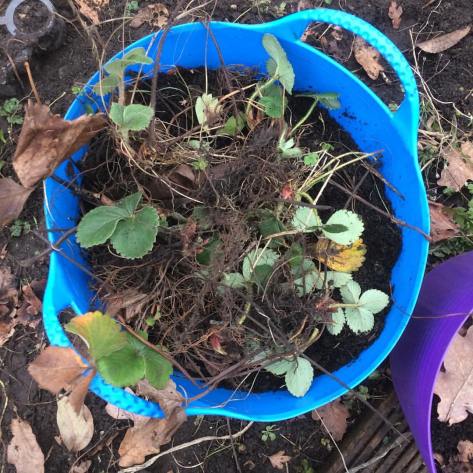Back in August I wrote about how I’d fallen for some hybrid berries while staying in North Yorkshire: boysenberries, tayberries and loganberries. They were so delicious I decided to plant some at my London plot in winter. I remember, in the sweltering heat, picking this fruit – all hybrids of blackberries and raspberries, to varying degrees – for crumbles and jam and wishing for cooler weather. This month has been so cold, much colder than we are used to in London, I’ve been longing for summer again.
The bare root plants of these three berries arrived last week. I bought them from Victoriana Nursery – http://www.victoriananursery.co.uk – which still has some of these hybrids for sale.

Planting bare root fruit trees must be done in winter, when the plants are dormant, before leaf burst in spring. If the ground is frozen, plant them or heel them in pots of compost until the frost disappears. Winter is also a good time to see where the gaps are in the plot, as most things have died back to reveal the structure from bare trees and fruit bushes. Over the past four years at Plot 35a I’ve been planting fruit trees at the sides of the allotment and edges of beds, mainly espaliers for the larger trees and training for the soft fruit bushes. There was a gap near to my artichoke bed and blueberries in pots which was perfect for the three new hybrids.

For each fruit bush I dug a hole and added some rotted manure or compost before planting, tying in a stake, adding more compost, watering well and firming the soil down with my welly. Don’t prune the newly planted bushes in the first winter as they need some time to establish. These hybrids grow like blackberries, in a rambling, sprawling habit, so it pays to keep it trained throughout the season.

Growing them along the edge of the plot means I can train them into a brambly hedge over the next few years – although the loganberry I’ve bought is thornless. In Yorkshire, I rated the boysenberry as my favourite of the three as it had the best flavour – sweeter than a blackberry and more full-bodied than a raspberry – and holds its shape well even with cooking. I made several jars of boysenberry, raspberry and blackberry jam which we soon went through once back in London.

The tayberry – brighter red and lighter in flavour than its boysenberry cousin – was my second favourite, and is sweet enough to eat straight from the bush. I rated the loganberry – a sharper flavour which needs cooking with sugar – third, although tastes, like the seasons, change. It is said to make excellent jam, so I am willing to keep an open mind about this ranking.

I still have plenty of weeding and bed clearing to do at the plot, and it is important to keep on top of this amid all the new season excitement of planting and seed-sowing. Making space for the hybrid berries, and digging out a lot of bindweed and other perennial weeds around the artichokes, I discovered I have a new half-bed to play with.

The only thing growing there were some allium bulbs, which I moved to a spot near to the blueberries. This means I now have this new space, a rarity in a London allotment, and am already making plans.

My plot has already been planned out for the year, with most veg accounted for. I always have little room left for sweetcorn – perhaps because I’m not a huge fan and it is one of the last veg to be sown. But this new half-bed is not quite big enough for sweetcorn. So perhaps some flowers, like the Alstroemeria ‘Indian Summer’ that my Dad and I admired at Kew Gardens during what was, in fact, the Indian Summer last year. Mark Diacono of Otter Farm and River Cottage recommends alpine strawberries, and I love the idea of them nestling near to the loganberry. My aunty Liz, who has a fabulous kitchen garden in Finland, suggests tagetes ‘Lemon Gem’ and old-fashioned marigolds, which she grows at the edges of her beds. Happily, I think the bed is large enough for a combination of all of these wondrous, brightly coloured things.

Speaking of strawberries, I need to renovate the bed where my ordinary strawberries grow: last year they were half in one bed and half in pots, but this season I want to keep them altogether, because it will be easier to net them if they are all in one place and keep the squirrels and birds off. This is my next major job, which I must do before the end of February. The problem with wishing for winter to be over is that, when you have too much work to do at the allotment, it slips away so quickly and spring rushes in while you are busy doing something else.

Super Jane, an informative and enjoyable read. Love the mention…
LikeLike
The variety of berries is great now. Nutritious too. Super blog! Good to mention Liz’s garden.
LikeLike
Lovely post Jane, would you recommend any of the hybrid berries in particular to grow? I’ve got a raspberry and blackberry but am interested in a hybrid too, thank you very much!
LikeLike
Hi Jen, I’m so sorry I’ve taken so long to respond! Blame the election. My favourite of the three is boysenberry.
LikeLike